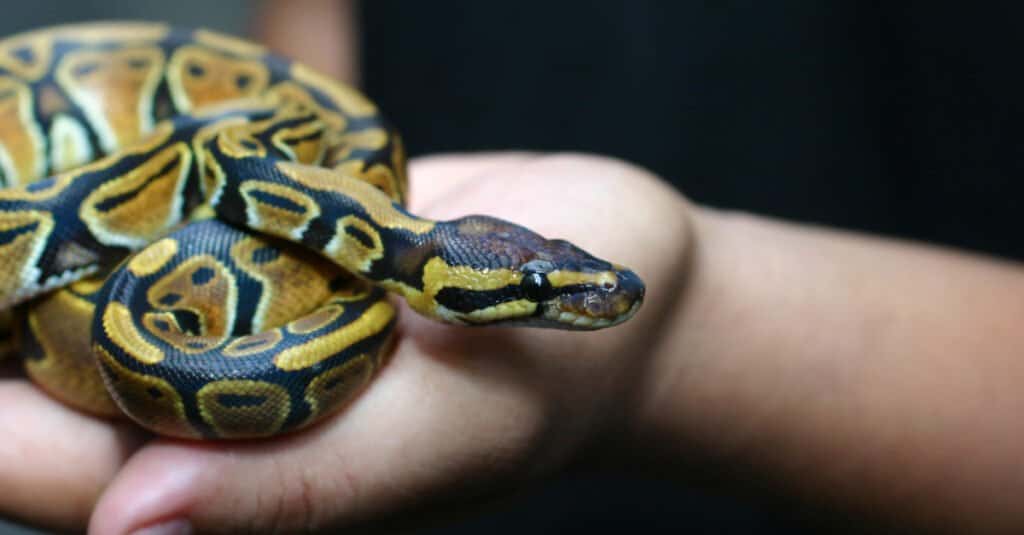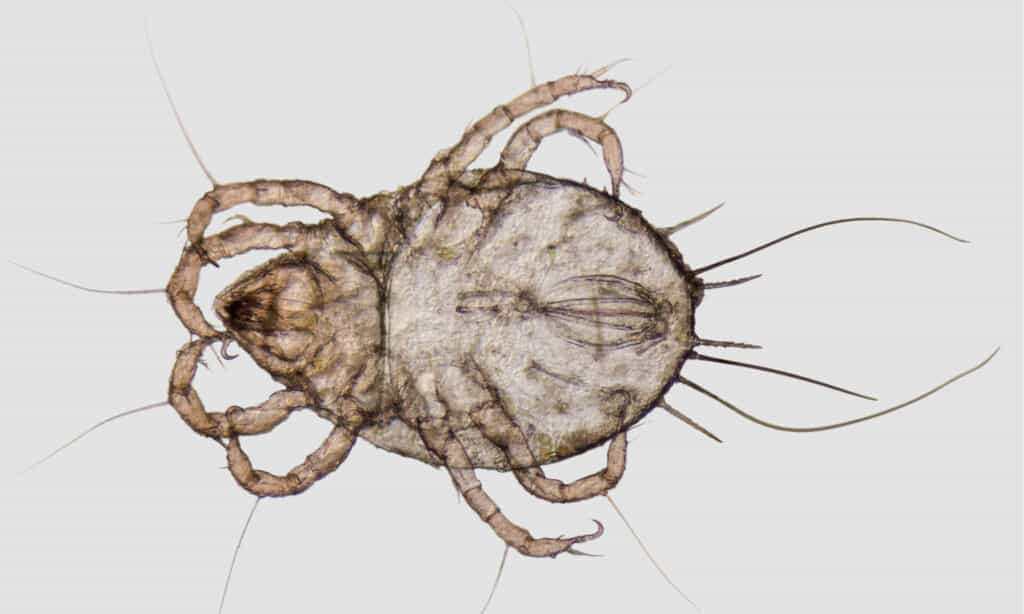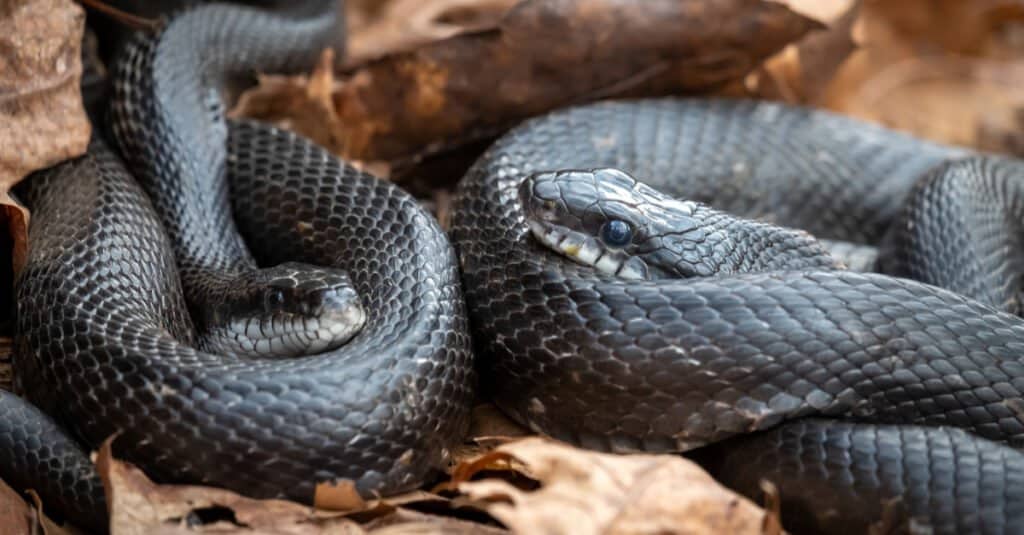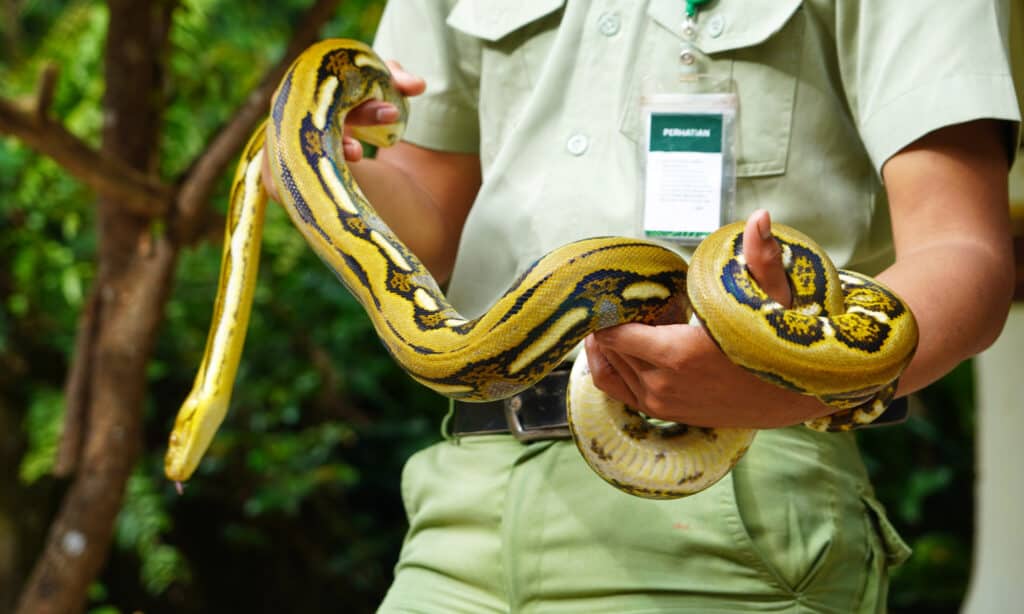Preventing harm to your pet snake is of the utmost importance. That’s why it is important to understand one of the most common ailments that affect snakes—snake mites. Snake mites are small parasitic insects that feed off of the blood of your snake. If you have a pet snake or regularly handle snakes, understanding what they are and how to treat them is important. Let’s discover: Snake mites, what they are and how to treat them.
What are snake mites?

Snake mites are small, parasitic
insects
that live off of the blood of your snake.
©Krisda Ponchaipulltawee/Shutterstock.com
There are three main species of mites that can affect snakes:
- Ophionyssus natricis
- Trombiculidae (a family of mites comonly known as “chiggers”)
- Ophionyssus acertinus (lizard mites)
Snake mites are tiny pests that primarily feed on the blood of a snake. They are incredibly tiny and difficult to see but can cause your snake to suffer. When left untreated, mites rapidly multiply and can number in the thousands. Even worse, snake mites can spread diseases between snakes when cross-contamination occurs. Today, we are going to be learning about these pesky insects, as well as the best ways to treat them.
What do they do?

Snake mites live on your snake and around the enclosure. They can be really tricky to get rid of.
©PRILL/Shutterstock.com
Snake mites are parasites. Essentially, their goal is to live off of a host for as long as possible and multiply as often as possible. To give an idea of how much of a nuisance they can be, an easy comparison for humans would be bed bugs or fleas. They itch, cause pain, and are generally gross creatures to have around.
The main nutrient source for mites is the blood of a snake. After some time, they reproduce (a single female alone can produce thousands of mites) and start the cycle over again. In severe infestations, snakes can become anemic from blood loss and become irritable and lethargic.
How do I tell if my snake has mites?

There are three main ways you can check your snake for mites: physical examination, behavioral tells, and a vet visit.
©Enrique Ramos/Shutterstock.com
Thankfully, it isn’t hard to tell if your snake has mites. Let’s go over a few of the most common ways.
Physical examination
A physical examination of your snake is often a great way to check for mites. Mites are small (about the size of a flea) and can be black, grey, or red. If you see small flecks moving around your snake or hands after handling, it’s likely mites. The most common places to see mites are around the eyes, in the labial pits, or in the skin folds across the body and lower jaw.
When checking your snake, make sure to check their eyes for swelling, as mites often attack around the eyes and in other sensitive areas. Also, a quick rub up your snake will reveal any raised scales. This is often the result of a snake that has been rubbing itself in an effort to get rid of the discomfort. Additionally, dysecdysis (abnormal shedding patterns) is a good tell.
Behavioral tells
Aside from physical tells, there are some behavioral things that snakes do in an attempt to rid themselves of mites. These can be combined with a physical examination to better confirm the presence of mites.
One of the most common ways snakes get rid of mites is through soaking. If your snake is constantly soaking, it is quite literally trying to drown the mites off of its body.
Additionally, irritability, lethargy, and reduced appetite are all signs that something is wrong. These aren’t always a clear sign that mites are present, but if your snake is exhibiting these traits plus some of the others, it is likely mites. Since mites can suck so much blood out of a snake, it can cause anemia.
Official inspection
If you still can’t tell, you can go an official route to check for mites.
The first thing you can do is bring your snake’s water bowl in for a veterinary examination. If your water bowl was recently cleaned or isn’t available, a sticky trap meant to catch small insects can be placed in the corner of the enclosure to potentially trap some mites.
Getting an official inspection of the mites allows your vet to diagnose what is going wrong with your snake. Additionally, it allows them to see exactly what kind of mite has been pestering your snake so that you can treat it correctly.
Are snake mites contagious to other snakes?

Snake mites can spread to other snakes and reptiles incredibly easy.
©samray/Shutterstock.com
All snakes have the potential to get mites. Of the three species of mites that can affect snakes, Ophionyssus natricis is by far the most common. These reptile mites are usually black, while the other two species are red.
In fact, snakes aren’t the only reptiles that can be affected by Ophionyssus natricis. Turtles, lizards, crocodiles, and more are all potential hosts for these annoying and dangerous creatures. With that in mind, any cross-contamination should be eliminated between snakes and other pets.
Are snake mites contagious to humans?
Snake mites are incredibly contagious and can easily be spread to other snakes and reptiles. Although human infection is rare, it does happen. When dealing with a snake mite infestation, the best thing to do is follow all recommended treatment options and thoroughly wash your hands.
Can snake mites cause diseases?
Snake mites are known carriers and sources of diseases for snakes. The most common diseases and bacterias spread by mites are:
- inclusion body disease
- ophidian paramyxovirus
- Aeromonas hydrophila (pneumonia and infectious stomatitis)
- Leucocytozoon
- certain hematozoa
What are the best treatment options?

In order to treat your snake for mites you need to spray with a medicated solution, soak their enclosure in a bleach solution, and prevent future occurrences from happening.
©Nawal Karimi/Shutterstock.com
Thankfully, snake mites can be treated by most people at home without a vet visit. It isn’t easy, but it can be done! Here are some of the steps.
1. Spray
The first step should be to get a spray that kills the mites but doesn’t harm your snake. Some common spray solutions include:
- liquid ivermectic (DON’T USE ON TURTLES OR LIZARDS AS IT CAN BE FATAL)
- Pro-vent-a-mite
- Frontline Spray
- Fipronil
Once a spray is selected, soak your snake for a few minutes, pat them dry, and apply a fine layer of your chosen spray. The snake should then be moved into a temporary plastic tub or container and left to sit. Be aware that some products can dehydrate your snake while they are working (namely ivermectin).
Also, be sure to read any specific directions that come with your chosen spray.
2. Soak and clean
Once your snake has been cleaned, it’s time for a deep clean of its enclosure. Using a 3% bleach solution (3 tablespoons per quart of water), soak everything from the enclosure. Keep the water hot (above 100 degrees) and fill up your tank to the top. You can also soak decor in a separate container to ensure they are totally clean.
After a soak, it’s time for some elbow grease. Using a clean sponge, scrub any possible area where a mite could have crawled to safety or avoided the water. Remember, a single mite can produce thousands of babies, and we don’t want to do this again.
After a solid soak and clean, it’s time to wipe your snake off, check for any remaining mites, and put them back into their squeaky clean enclosure.
3. Prevention
There are a few rules to follow that can help prevent snake mites from returning.
- First, always wash your hands after handling someone else’s snake. You can’t always see mites or their eggs and you could be bringing them back with you.
- Keep your snakes enclosure clean. Regular deep cleans and checks are a sure way to keep mites from making a home of your snakes enclosure.
- Quarantine any new snakes, whether wild or captive bred, for qt least 1-2 months. This won’t only help with snake mites, but with other potentiall harmful things that can be tranmissable between reptiles.
The photo featured at the top of this post is © Nawal Karimi/Shutterstock.com
Discover the "Monster" Snake 5X Bigger than an Anaconda
Every day A-Z Animals sends out some of the most incredible facts in the world from our free newsletter. Want to discover the 10 most beautiful snakes in the world, a "snake island" where you're never more than 3 feet from danger, or a "monster" snake 5X larger than an anaconda? Then sign up right now and you'll start receiving our daily newsletter absolutely free.
Thank you for reading! Have some feedback for us? Contact the AZ Animals editorial team.






